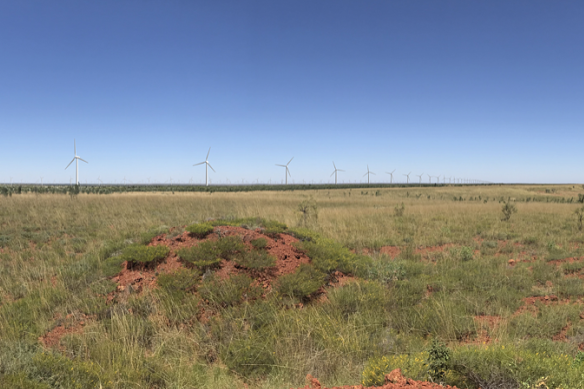By Peter Milne
Macquarie Group will sell its share of the $55 billion flagship for Australia’s dream of green hydrogen exports, likely leaving BP with a 64 per cent stake in a vast project to export clean fuel from WA’s Pilbara.
The Australian Renewable Energy Hub, which sprawls 6500 square kilometres of northern WA, plans to install over a decade more than 1700 wind turbines and enough solar panels to produce 26 gigawatts of emissions-free electricity – nine times more than Australia’s largest power station, Eraring in NSW.

The project’s site offers vast space for wind and solar power but its remoteness will add to construction costs.Credit: Asian Renewable Energy Hub - photo montage
A BP spokesman said as the operator and major shareholder, it was perfectly poised to buy Macquarie’s stake. Macquarie Group did not respond to questions from this masthead.
The size and target market for the ambitious project has changed several times over the past seven years.
In 2017, two international energy project developers InterContinental Energy and CWP Global launched the Asian Renewable Energy Hub to send six gigawatts of emissions-free power to Indonesia through a subsea cable.
Macquarie joined in 2019, when the capacity of the project was doubled to also sell power to WA’s iron ore-rich Pilbara region to the south.
The participants later doubled down again, increasing the size of the project to its current 26 gigawatts of solar panels and wind turbines to produce green ammonia for export, and dumping supplying power to Indonesia from their plans.
The switch greatly increased the scope and complexity of what had to be done in an area that is remote even by the standards of north-west WA.
The now-$US36 billion ($55 million) project needs vast banks of electrolysers run by renewable power to split hydrogen from water sourced from a desalination plant.
That hydrogen, a difficult-to-transport gas, would then be combined with nitrogen from the atmosphere to make liquid ammonia for export. Its eventual production of 1.6 million tonnes a year of green hydrogen would allow nine million tonnes of ammonia to be made.
In 2021, Australia’s biggest proposed renewable energy project was judged to be “clearly unacceptable” by then-Coalition environment minister Sussan Ley due to potential impacts on a wetland habitat for migratory birds from the project’s jetty to load ships with ammonia.
The setback did not deter BP buying its 48 per cent stake a year later and taking over as operator.
The BP spokesman said it had made significant progress since taking control and was continuing to develop the project to produce clean power and green hydrogen to industry in the Pilbara and green energy for export.
Should the sale of Macquarie’s stake to BP be completed, the $150 billion energy giant will have a 64 per cent stake and project founders InterContinental Energy and CWP Global a 26 per cent and 10 per cent stake, respectively.
Read more
‘Better late than never’: US giant Alcoa set to take over Australian partner in $3.3b deal
WA Liberals want probe into Burke’s links to $22.3 million grants program
Grieving WA mother speaks out after crash claims twin daughters